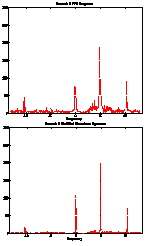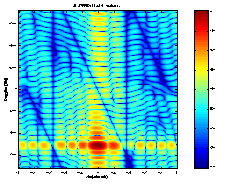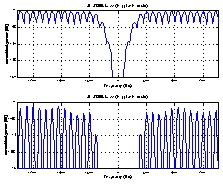

Spectral Estimation - LSI has expertise with a number of parametric
(e.g., Maximum Entropy or Burg, Modified Covariance, Eigenanalysis or Singular
Value Decomposition, etc.) methods of spectral estimation in 
 addition to conventional nonparametric (Fourier) processing. Shown
here is analysis involved with defining a baseline signal processing
suite for a limited dwell S-band surveillance sensor non-cooperative target
identification (NCTI) capability. In order to overcome the spectral
resolution limitations associated with limited coherent dwell operation
and conventional processing, autoregressive (AR) non-linear parametric methods
of spectral estimation were investigated to provide a relatively modest factor
of four improvement in spectral resolution. The improvement factor
was required to enable proven NCTI algorithms to have sufficient resolution
for the extraction of discriminating spectral features. Shown here are
sample results of applying the parametric techniques to real target data.
While the spectrum in the upper left corner is the result of conventional
processing, the other three results clearly illustrate the ability of parametric
techniques to preserve and/or enhance spectral features. In addition,
LSI sourced and advanced other nonconventional nonparametric techniques for
coherently combining individual PRF dwells that included up-sampling and
down-sampling, fractional time-delay all-pass filter banks and wavelet decomposition-reconstruction
filter banks.
addition to conventional nonparametric (Fourier) processing. Shown
here is analysis involved with defining a baseline signal processing
suite for a limited dwell S-band surveillance sensor non-cooperative target
identification (NCTI) capability. In order to overcome the spectral
resolution limitations associated with limited coherent dwell operation
and conventional processing, autoregressive (AR) non-linear parametric methods
of spectral estimation were investigated to provide a relatively modest factor
of four improvement in spectral resolution. The improvement factor
was required to enable proven NCTI algorithms to have sufficient resolution
for the extraction of discriminating spectral features. Shown here are
sample results of applying the parametric techniques to real target data.
While the spectrum in the upper left corner is the result of conventional
processing, the other three results clearly illustrate the ability of parametric
techniques to preserve and/or enhance spectral features. In addition,
LSI sourced and advanced other nonconventional nonparametric techniques for
coherently combining individual PRF dwells that included up-sampling and
down-sampling, fractional time-delay all-pass filter banks and wavelet decomposition-reconstruction
filter banks.
Multisensor, Multitarget Tracking - LSI maintains an avid interest
in advancing and applying the latest state estimation concepts to the multisensor,
multitarget tracking problem. LSI’s staff is knowledgeable and experienced
in  designing and implementing Kalman and a-b tracking concepts for use in filtering, smoothing
(e.g., fixed-point, fixed-lag and fixed-interval) and prediction applications.
The company has a strong background in utilizing data association techniques
that range from nearest neighbor to multiple hypothesis testing (MHT) and
joint probabilistic data association (JPDA). Shown here is a steady-state
analysis demonstrating the performance penalty (or lack thereof) for track-to-track
fusion as compared to measurement fusion. The plot illustrates the
differences in the elements of the error covariance matrix of the fused
track for the two approaches, as a function of the measurement accuracy
ratio of the two sensors. The analysis established that less than
7% steady-state performance enhancement is achieved from using measurement
fusion as opposed to track-to-track fusion.
designing and implementing Kalman and a-b tracking concepts for use in filtering, smoothing
(e.g., fixed-point, fixed-lag and fixed-interval) and prediction applications.
The company has a strong background in utilizing data association techniques
that range from nearest neighbor to multiple hypothesis testing (MHT) and
joint probabilistic data association (JPDA). Shown here is a steady-state
analysis demonstrating the performance penalty (or lack thereof) for track-to-track
fusion as compared to measurement fusion. The plot illustrates the
differences in the elements of the error covariance matrix of the fused
track for the two approaches, as a function of the measurement accuracy
ratio of the two sensors. The analysis established that less than
7% steady-state performance enhancement is achieved from using measurement
fusion as opposed to track-to-track fusion.
Space Time Adaptive Processing (STAP) - The detection and tracking
performance improvements realized by space-time adaptive processing techniques
will undoubtedly justify their utilization in next generation  airborne surveillance sensors that possess array antenna architectures.
LSI maintains considerable expertise in STAP concepts that range from algorithm
development and refinement, to in-situ performance modeling and hardware
implementation. As an illustration of basic STAP concepts, the figure
on the left represents a classical STAP architecture with m time
taps spaced at the PRI for each of the n spatial channels.
The figures below illustrate the performance of a joint optimum STAP algorithm
with an ideal covariance matrix constructed from 16 channels and 32 pulses.
The plot on the lower left indicates an optimized response intended to preserve
the indicated look direction and Doppler filter, while simultaneously nulling
two jammers and ambiguous platform motion induced antenna sidelobe clutter
Doppler. The plot on the lower right indicates the signal-to-interference
plus noise loss that results from applying the STAP algorithm to the entire
Doppler space for a particular look direction. The results indicate
that free space performance is recovered to within ~0.25 dB over almost
all of the usable Doppler space.
airborne surveillance sensors that possess array antenna architectures.
LSI maintains considerable expertise in STAP concepts that range from algorithm
development and refinement, to in-situ performance modeling and hardware
implementation. As an illustration of basic STAP concepts, the figure
on the left represents a classical STAP architecture with m time
taps spaced at the PRI for each of the n spatial channels.
The figures below illustrate the performance of a joint optimum STAP algorithm
with an ideal covariance matrix constructed from 16 channels and 32 pulses.
The plot on the lower left indicates an optimized response intended to preserve
the indicated look direction and Doppler filter, while simultaneously nulling
two jammers and ambiguous platform motion induced antenna sidelobe clutter
Doppler. The plot on the lower right indicates the signal-to-interference
plus noise loss that results from applying the STAP algorithm to the entire
Doppler space for a particular look direction. The results indicate
that free space performance is recovered to within ~0.25 dB over almost
all of the usable Doppler space.

